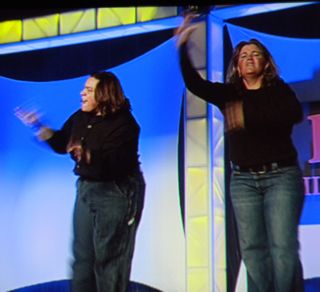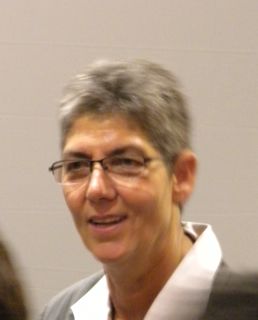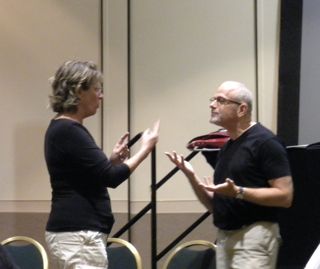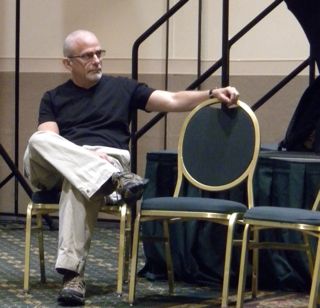It was a well-chosen theme for the 24th national conference of the Registry of Interpreters for the Deaf, although one requires knowledge of the organization’s history in order to be able to fully appreciate the dual challenge of embracing change and honoring tradition. Depending upon point-of-view and experiences, any given change can be viewed negatively or positively, and tradition can be variously described.  President Cheryl Moose (pictured, watching (“listening”) during the DEAF FRIENDLY workshop) interpreted the motto for us in her speech at the Opening Ceremony, using an ASL sign for “embrace” that indicates taking a thing from outside of yourself and tucking it into the front pocket of your heart. The ASL sign that she preferred for “honor” is the sign usually glossed as CHERISH. The thing is, if you are relatively new to the field or have only attended a few conferences or less, then you have no way to assess what is traditional or what constitutes change.
President Cheryl Moose (pictured, watching (“listening”) during the DEAF FRIENDLY workshop) interpreted the motto for us in her speech at the Opening Ceremony, using an ASL sign for “embrace” that indicates taking a thing from outside of yourself and tucking it into the front pocket of your heart. The ASL sign that she preferred for “honor” is the sign usually glossed as CHERISH. The thing is, if you are relatively new to the field or have only attended a few conferences or less, then you have no way to assess what is traditional or what constitutes change.
The history lessons came at the end of the conference, during a workshop by MJ Bienvenu (The Heart of RID), the Closing Ceremony (RID – The Musical), and a strategy session on making the organization – and particularly the next conference – more DEAF-FRIENDLY. These three events exposed longterm (historical) dynamics, which (especially if taken together) drew out current group tensions. Beyond the quantitative indicators of growth, there are qualitative indicators of change – and resistance to change! – showing which tensions are shaping group development now. If one can get some intellectual distance, our own topics of conversation and modes of interacting provide us with the means to measure how much we have grown (individually and collectively) in dealing with them.
Stuck in the Past?
 Maria Ruiz-Williams and Amie Seiberlich presented a “musically inspired ASL storytelling” (see Sherry Hicks) performance of Lou Fant’s Silver Threads: a personal look at the first 25 years of the Registry of Interpreters for the Deaf. I do not know if it was by plan or coincidence that MJ Bienvenu’s history from 1983-1991 fit so closely with Fant’s timeframe (1964-1989), but the selections presented by Ruiz-Williams and Seiberlich in their interpretation provide a contextualization that could serve as organizational background in which to understand how and why MJ was so shocked by the organization’s resistance (in 1983) to her initiative requesting official recognition of ASL. She was not born radical, she was made to appear radical by the intransigence of people reluctant to share power.
Maria Ruiz-Williams and Amie Seiberlich presented a “musically inspired ASL storytelling” (see Sherry Hicks) performance of Lou Fant’s Silver Threads: a personal look at the first 25 years of the Registry of Interpreters for the Deaf. I do not know if it was by plan or coincidence that MJ Bienvenu’s history from 1983-1991 fit so closely with Fant’s timeframe (1964-1989), but the selections presented by Ruiz-Williams and Seiberlich in their interpretation provide a contextualization that could serve as organizational background in which to understand how and why MJ was so shocked by the organization’s resistance (in 1983) to her initiative requesting official recognition of ASL. She was not born radical, she was made to appear radical by the intransigence of people reluctant to share power.
The change to celebrate is that MJ was personally invited by the President of RID, key board members, and Deaf advisors to deconstruct any lingering audism evident in the organization.  MJ delivered with surgical precision, using RID’s official webpages to hold up a mirror to the deep audist roots still evident to anyone who knows how to recognize them. An equivalent would be if, for instance, the Interpreting Directorate at the European Parliament invited advocates for linguistic equality from the new languages to publicly critique inadequacies in the delivery of interpreting services for the institution as a whole. Another change evident this year at RID is the standing ovation MJ received for the information and her courage, returning to Philadelphia (the scene of a media-sensationalized event in the early ’90s concerning interpreted music), and persisting in her educational efforts to engage a large population of very slow learners.
MJ delivered with surgical precision, using RID’s official webpages to hold up a mirror to the deep audist roots still evident to anyone who knows how to recognize them. An equivalent would be if, for instance, the Interpreting Directorate at the European Parliament invited advocates for linguistic equality from the new languages to publicly critique inadequacies in the delivery of interpreting services for the institution as a whole. Another change evident this year at RID is the standing ovation MJ received for the information and her courage, returning to Philadelphia (the scene of a media-sensationalized event in the early ’90s concerning interpreted music), and persisting in her educational efforts to engage a large population of very slow learners.
What has not changed is the resistance to being an ASL-based organization. This is a kind of “tradition” that we could probably do without, if us hearing people could come to recognize the many ways we play into the linguistic hegemony of spoken English. What I wonder, though, is the extent to which hearing (non-deaf) resistance to immersion in visual communication is coupled – dynamically – with a kind of Deaf kneejerk reaction against even the hint of music? I agree it was too much to have the Opening Reception and the Closing Ceremony both rely on interpreted song, but – especially for the Closing Ceremony – the point was the history, the music was incidental. I wonder two things about the displays of anger and disappointment that I witnessed among some audience members during the RID Musical performance that were repeated during the DEAF-FRIENDLY workshop. “No one stopped it,” one person said, “but they should have.” First, it seems important to ask, how much is this resistance simply generational? Is the older Deaf activist core passing on a prejudice? I realize that Sean Forbes’ capital-D Deaf cred may be questioned, but I would be stunned if anyone doubts Rosa Lee’s. I am not aware of any young Deaf people who were upset by either performance at RID (which doesn’t mean that they weren’t, but I did not witness it). The second hypothesis involves a variation of struggle between the culturally Deaf and the Hard-of-Hearing (which, audiologically, includes both capital-D, culturally Deaf, like children of Deaf parents who learned ASL as their native language, and the audiologically deaf, for whatever reason and from non-deaf as well as deaf origins).
At any rate, the new potentials of communications technology open up so many possibilities that it does seem like it would not beyond conception to generate forms of entertainment that are visually-based and reflective of traditional internal Deaf cultural aesthetics.
RID Conferences as A Professional Development Experience:
 Janis Cole and Lewis Merkin facilitated the DEAF-FRIENDLY workshop, which I participated in with a mix of pride and dismay. I’m old enough, and been around long enough, to be able to recognize my younger self in some of the new interpreters. Of the more than sixty people who stayed, I recognized somewhat less than a third, a comforting familiarity (we’re still in this together), but because the numbers were skewed to newer/younger members the discussion went that way, too. The beautifully-orchestrated beginning to a short de-briefing of the conference experience transformed quickly into a venue for diagnosis and performance for a specific demographic: white hearing women. As I watched one after another raise their hand to be called upon, I resolved to keep my butt in my chair no matter how inspired I was to say something. 😉
Janis Cole and Lewis Merkin facilitated the DEAF-FRIENDLY workshop, which I participated in with a mix of pride and dismay. I’m old enough, and been around long enough, to be able to recognize my younger self in some of the new interpreters. Of the more than sixty people who stayed, I recognized somewhat less than a third, a comforting familiarity (we’re still in this together), but because the numbers were skewed to newer/younger members the discussion went that way, too. The beautifully-orchestrated beginning to a short de-briefing of the conference experience transformed quickly into a venue for diagnosis and performance for a specific demographic: white hearing women. As I watched one after another raise their hand to be called upon, I resolved to keep my butt in my chair no matter how inspired I was to say something. 😉
What happened then – because I *did* sit on my idea! – was being perhaps too eager to share it in my own small group. They really wanted to define DEAF-FRIENDLY, but I wanted to jump to envisioning implementation. The experience was frustrating, but I did feel as if I understood what was happening. We were given a list of questions to choose among and discuss, someone immediately asked about defining DEAF-FRIENDLY but I jumped in, asking, “Can I jump to another topic? I have an idea about setting up the next conference….” I shared it, they watched me (we were all signing), and when I finished another member in the group asked, “Why do you think it is that we always talk about students’ learning when the topic is about being DEAF-FRIENDLY?” At the time, I could perceive absolutely no relationship between what she said and what I had said. This did not seem to be a turn in a conversation, not listening, but waiting for the next gap in which to speak.
Hmmm. I observed how the rest of the discussion went in our small group. The next speaker went into a lengthy discussion of how “we always talk about using ASL, making it policy, over and over…” He admitted, being hearing, to having a natural tendency to follow verbal speech, and then shared a litany of personal experiences. I was reminded of a comment Betty Colonomos made at the beginning of the Business Meeting when we were discussing the Standing Rules: that people have no voice out there in the world, but we have one here and people need to use it. So everyone got their chance to speak but we did not actually converse. Why is that? I think (in this case) it had to do with time and timing. Because this event came at the end of the conference, people really needed to debrief.  The immediate felt need was to process this experience in relation to the past. People with more practice reflecting on these kinds of dynamics were able to bring their awareness more into the present, but the move to imagining the future was premature. The ground was not prepared either prior to or during the conference, and we did not have enough time in this venue to wade through the individual processing until everyone was at a sufficiently-sated stage of self-disclosure and internal satisfaction to shift, collectively, to action planning.
The immediate felt need was to process this experience in relation to the past. People with more practice reflecting on these kinds of dynamics were able to bring their awareness more into the present, but the move to imagining the future was premature. The ground was not prepared either prior to or during the conference, and we did not have enough time in this venue to wade through the individual processing until everyone was at a sufficiently-sated stage of self-disclosure and internal satisfaction to shift, collectively, to action planning.
In the end, I think what we generated as a group in this workshop was a venue for hearing interpreters to vent. One of the first Deaf speakers said, forthrightly, that she felt that most of us “cannot walk and sign at the same time.” Another Deaf person commented on the lack of tolerance most hearing people have (at least in this context) “for missing a little bit once in awhile.” That observation reminded me of my experience with other languages in Europe, which I described in a blogpost at the time as “cotton ’round the brain.” In a discussion following that blog entry, I tried to describe how awareness of perceptible stimuli simply shifts depending on the language one knows – or does not know. The main message I gleaned from the way the DEAF-FRIENDLY discussion unfolded in our small group is that it seems we assume being DEAF-FRIENDLY means being non-deaf/hearing unfriendly: as if the two are
-
a) extreme opposites and
b) in competition with each other.
I do not believe this needs to be the case.
RID: The Musical, Maria Ruiz-Williams and Amie Seiberlich
Silver Threads: a personal look at the first 25 years of the Registry of Interpreters for the Deaf, by Lou Fant. PDF available from the Maine RID Interpreter’s Library.
Reading between the signs (an excerpt quoting Lou Fant), by Anna Mindess
“Musically Inspired ASL Storytelling” by Sherry Hicks
Sean Forbes, D-PAN, Deaf Performing Artists Network
The Rosa Lee Show
Cotton ’round the brain, comment by steph
View all posts in series Interpreting
Previous in Series: The eyes have it! (RID 2009) — Next in Series: Framing the Future: Atlanta 2011







Beautifully said!
[…] Embrace Change, Honor Tradition […]
[…] Embrace Change, Honor Tradition […]